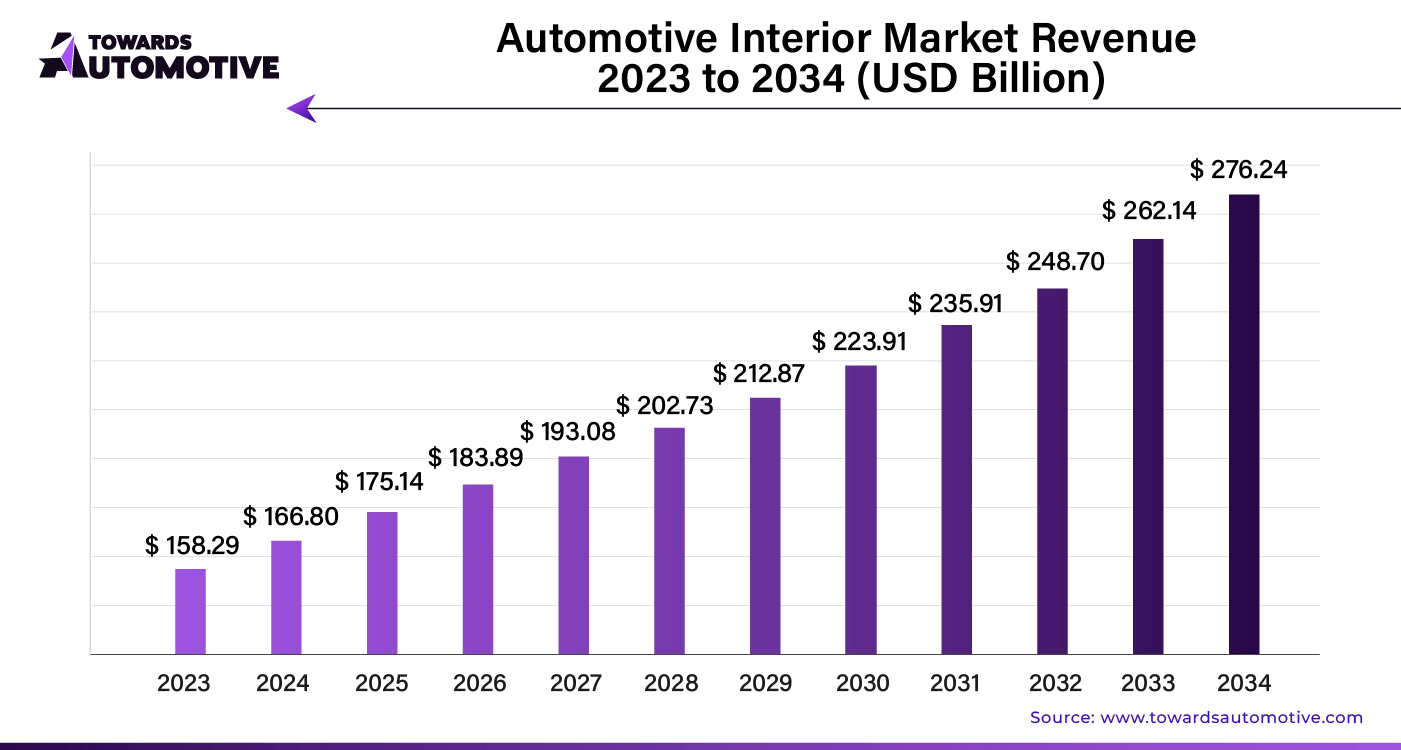April 2025
The global automotive interior market size is calculated at USD 166.80 billion in 2024 and is expected to be worth USD 276.24 billion by 2034, expanding at a CAGR of 5% from 2023 to 2034.

Unlock Infinite Advantages: Subscribe to Annual Membership
The automotive interior market is expanding rapidly as consumers increasingly seek connected features. In-car Wi-Fi, seamless smartphone integration, and advanced navigation systems are becoming essential elements, boosting market growth.
Additionally, heightened awareness of safety features is fueling this market's expansion. The growing emphasis on safety is driving innovations and advancements in automotive interiors, reflecting the rising importance placed on vehicle safety. The automotive market valued at USD 4,070.19 billion in 2023, is experiencing growth and is projected to surpass USD 6,678.28 billion by 2032, with a significant CAGR of over 5.66%.
The automotive interior market is booming due to several key factors:
Raw Material Price Fluctuations: Variations in the costs of metals, plastics, and leather directly affect manufacturing expenses.
Cybersecurity Concerns: As digital technologies and connectivity become more prevalent in vehicles, safeguarding against cybersecurity threats becomes increasingly crucial.
Evolving Consumer Preferences: The shift toward shared mobility and digital experiences is reshaping interior design and feature requirements.
Autonomous Vehicle Design: Integrating new functionalities for autonomous vehicles presents challenges in maintaining user comfort and safety while adapting interior designs.
Rising Consumer Expectations: Rapidly changing design trends and demands for personalized interiors make it difficult to meet and exceed consumer expectations.
AI integration is transforming the automotive interior market by enhancing user experience and driving market growth. AI-powered systems are enabling smarter and more intuitive interfaces, allowing drivers and passengers to interact with their vehicles through voice commands, gestures, and personalized settings. This integration improves convenience, safety, and overall comfort, which attracts consumers seeking advanced, user-friendly technologies.
Advanced AI algorithms analyze driver behavior and preferences, offering personalized recommendations for climate control, infotainment, and seating adjustments. This personalization enhances driving comfort and satisfaction, fostering brand loyalty and boosting sales. Additionally, AI-driven safety features, such as real-time monitoring and predictive analytics, enhance vehicle safety by alerting drivers to potential hazards and preventing accidents.
The incorporation of AI also supports the development of autonomous driving technologies, which rely on sophisticated AI systems to process data from sensors and cameras. This innovation not only improves the driving experience but also opens new opportunities for interior design and functionality, catering to a growing demand for automated and connected vehicles.
Overall, AI integration is a key driver of growth in the automotive interior market, shaping the future of vehicle design and enhancing consumer appeal.
In the automotive interior market, an efficient supply chain is crucial for meeting rising consumer demands and staying competitive. Suppliers need to ensure timely delivery of high-quality materials such as leather, fabrics, and electronic components. Effective supply chain management involves close coordination between manufacturers, suppliers, and logistics providers to streamline operations and reduce lead times.
Automakers and suppliers must invest in advanced forecasting tools to predict demand accurately and adjust production schedules accordingly. Implementing just-in-time (JIT) inventory systems can minimize excess stock and reduce costs, while real-time tracking systems enhance transparency and enable quicker responses to disruptions.
Collaboration with suppliers is vital for quality control and innovation. By fostering strong partnerships, automakers can gain access to cutting-edge materials and technologies, improving product differentiation. Additionally, adopting sustainable practices in the supply chain helps meet growing environmental regulations and consumer expectations.
Overall, a well-integrated supply chain ensures a steady flow of materials, maintains production efficiency, and supports the market’s growth by enhancing responsiveness and adaptability.
The automotive interior market thrives on several essential components, including seats, dashboards, infotainment systems, and climate control systems. Seats are vital for comfort and safety, driving innovations in ergonomics and material technology. Dashboards, which house controls and displays, are increasingly integrated with advanced electronics and user interfaces. Infotainment systems, combining entertainment and navigation features, are central to enhancing the driving experience. Climate control systems, crucial for passenger comfort, integrate advanced temperature regulation and air quality management.
Companies like Faurecia, Magna International, and Lear Corporation significantly contribute to this market ecosystem. Faurecia excels in producing high-quality seating and interior systems, leveraging innovations to improve safety and comfort. Magna International offers a broad range of components, from seats to electronics, focusing on enhancing vehicle functionality and driver experience. Lear Corporation is renowned for its advanced seating solutions and electrical systems, emphasizing safety, comfort, and connectivity.
Together, these companies drive technological advancements and meet evolving consumer demands, shaping the future of automotive interiors with a focus on innovation, comfort, and connectivity.
South Korea is poised as the fastest-growing market for automotive interiors, with a forecasted CAGR of 7.2% from 2024 to 2034. This growth is propelled by South Korea's emphasis on technological advancement and modern interiors. Consumers in this region increasingly seek advanced infotainment systems, connectivity features, and premium materials, reflecting a broader trend towards sophisticated technology in automotive design.

Japan also demonstrates robust market performance with a projected CAGR of 6.4%. Growth in the Japanese market is driven by high demand for state-of-the-art technology, including infotainment systems and safety features, along with a surge in demand for customized vehicle interiors. The popularity of compact cars in Japan necessitates efficient use of interior space and features tailored to urban mobility needs.
The United Kingdom follows with an anticipated CAGR of 6.1%. The UK's automotive interior market growth is driven by a strong demand for luxury vehicles and high-end interiors. Additionally, there is an increasing trend toward eco-friendly and sustainable designs as consumers become more environmentally conscious.
China shows significant market activity with a CAGR of 5.9%. As a key global player, China's automotive interior market benefits from its expanding middle class and a growing preference for luxurious, visually appealing interiors. Support for electric and new energy vehicles from the government also contributes to market expansion.
img
The United States experiences steady growth with a CAGR of 5.5%. American consumers value comfort, advanced technology, and premium materials, driving the demand for sophisticated interior solutions. The steady market growth reflects a consistent interest in high-quality automotive interiors.
Overall, South Korea leads in growth rate, while Japan, China, and the United States maintain substantial market influence, showcasing diverse regional demands and trends in automotive interior design.
In the automotive market, the cockpit module segment is poised for significant growth, with an anticipated CAGR of 4.6% from 2024 to 2034. This growth is fueled by the rising demand for safety features such as airbags, collision warning systems, and adaptive cruise control, which are central to cockpit modules. Additionally, the push for enhanced connectivity and intuitive user interfaces drives the demand, as automakers aim to set their brands apart with distinctive cockpit designs.
Conversely, the passenger car segment is expected to maintain a dominant market share throughout the forecast period. It is projected to grow at a CAGR of 4.4% from 2024 to 2034. Buyers of passenger cars place a high value on comfort and advanced technology. Features like touchscreen infotainment systems, voice recognition, and advanced driver assistance systems (ADAS) are key to the segment's strong market position.
Key players in the automotive interior market are focusing on research and development to offer advanced, premium, and comfortable interior systems. Many are forming strategic partnerships with local firms in developing countries to broaden their distribution networks.
A growing trend is the increased emphasis on product differentiation, which is likely to challenge global market leaders as regional players expand.
In January 2023, Visteon and Qualcomm Technologies, Inc. enhanced their technological collaboration. Their joint effort aims to develop a high-performance cockpit domain controller, designed to help global automakers build next-generation cockpits, demonstrating a commitment to advancing automotive technology.
By Component
By Vehicle Type
By Region
April 2025
April 2025
April 2025
April 2025
Dr. Arjun Patel is a distinguished expert in the automotive industry, holding advanced degrees in Automotive Engineering and Mechanical Engineering. His expertise spans automotive market dynamics, technological advancements, and sustainable practices. Dr. Patel excels in conducting in depth research and analysis on market trends, consumer preferences, and the economic implications within the automotive sector. He is renowned for his insightful publications on topics such as electric vehicles, autonomous driving technologies, and the evolution of sustainable transportation solutions. Dr. Patels research contributions have significantly advanced understanding in the field, earning him recognition as a leading authority in automotive research and analysis.
We offer automotive expertise for market projections and customizable research, adaptable to diverse strategic approaches.
Contact Us